Simple DIY Tallow Balm Recipe (2 Ingredients!)
It’s no secret that we are big fans of tallow around here. Whether using for cooking or skincare products, tallow is a staple for our family. After trying everything under the sun to help my skin, prone to dryness, tallow balm has been far and away my favorite.
After our infant son began to experience dry skin and eczema patches as well, tallow balm has taken permanent residence in our medicine cabinet. Thankfully, with only two ingredients, making it yourself at home is super easy.
We’ll walk you through exactly how you can make your own homemade tallow balm and why you might want to!

Our Story – Why We Use Tallow
Ever since I was a young child, I had highly sensitive skin. From cracked skin after spending time in the swimming pool, to lathering Aquaphor on my face in the dry winter months, dry skin has always plagued me. Thankfully, I’ve come a long way.
After changing to a real, whole food diet and incorporating nutrient dense foods like liver, most of the skin issues that I’ve always had have completely resolved.
However, occasionally in the winter months when the air is dry, I can still get a bit of dry skin. For these instances, I rely on tallow balm.

I wanted to have something on hand with natural oils—not filled with toxic ingredients—to help when dry skin patches appeared. That’s when I first learned of tallow for skin care. Soon after, I whipped up my first batch of our very own tallow balm and was hooked.
Now, almost all of the natural products used in our skincare routine are tallow based like our shampoo bars, magnesium lotion, sunscreen, and drawing salve.
What is Tallow Balm?
Tallow balm is a nourishing and natural skin moisturizer with the main ingredient being tallow or rendered beef fat. Because tallow is a solid at room temperature, another liquid oil (we prefer olive oil) is added to the tallow to give tallow balm a texture better suited for easy application on skin.
While it may sound funny to promote the wonders of a beef tallow moisturizer, tallow for skincare has actually been used throughout history.
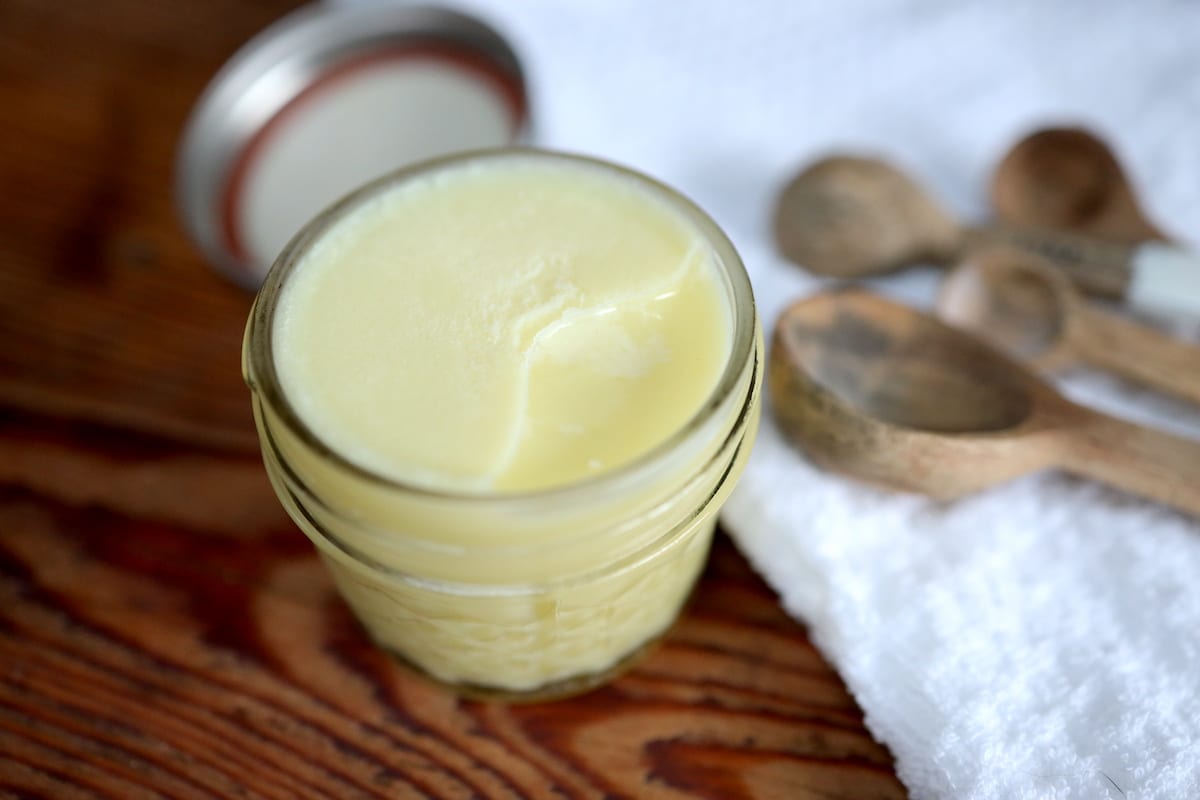
Dating back to medieval times, the Romans and ancient Egyptians have used tallow as a miraculous agent of healing for skin. Whether used as a soap, balm, or tallow lotion, tallow has long been touted for its ability to moisturize, along with the potential for helping to heal other skin ailments like burns and scrapes.
Why Use Tallow Balm for Skin?
There are so many benefits to using tallow on the skin. After first trying it, we were so pleased with how it felt and what it did for our skin that we haven’t looked back.
Tallow has been used both internally and externally for hundreds of years and with good reason—its benefits are hard to beat!
- High in vitamins A, D, E, K, and B12
- Rich in minerals
- Contains conjugated linoleic acid (CLA) with natural anti-inflammatory properties
- Palmitoleic acid is a powerful antimicrobial agent that is also a basic building block of our skin
- Palmitic acid helps to improve the function of the skin’s protective barrier
- Stearic acid helps to repair damaged skin and improves the skins flexibility and suppleness
This list just begins to scratch the surface of the nourishing benefits that tallow balm has for the skin. But, making it yourself can be intimidating, so let’s dive in!
What do You Need to Make Tallow Balm?
This all-purpose skin balm has only 2 ingredients.
Rendered Tallow – More on that below.
Extra Virgin Olive Oil – Avocado oil would be a good substitute. You need an oil that’s a liquid at room temperature so coconut oil wouldn’t be a good option.
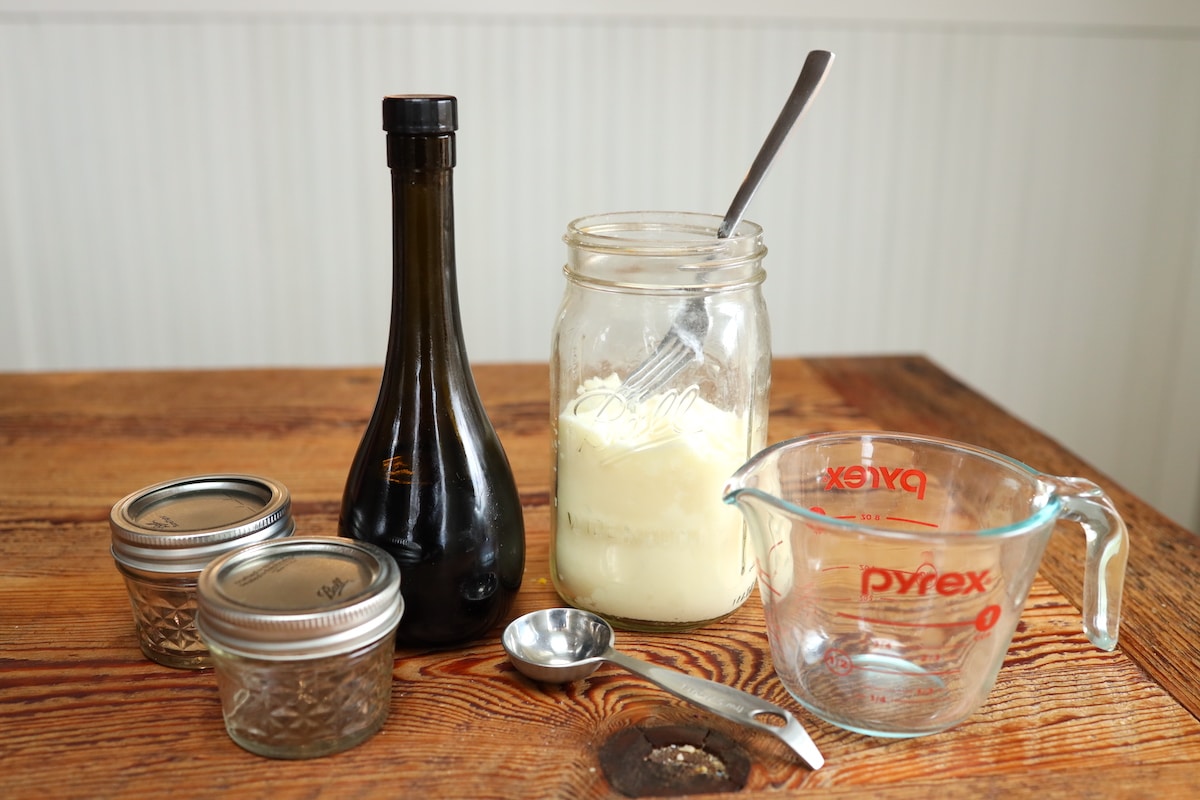
How to Render Tallow to Make Tallow Balm
Tallow is rendered beef fat (AKA suet). The first step is rendering your animal fat down to turn it into liquid tallow.
There are two methods for doing this, the dry and wet methods.
The dry method for rendering tallow is great and very straightforward. You can learn exactly how to render tallow this way in our post Cooking with Lard and How to Render It Yourself—the process of rendering lard and tallow is exactly the same. This method is great for rendering tallow to use in cooking but can still leave the tallow with a slightly beefy scent.

To avoid the smell, when we are rendering tallow for use in skin care, we prefer the wet method. The wet method of rendering tallow is slightly more involved but it leaves you with a beautiful, white, odorless tallow. Here’s our full step-by-step guide for wet rendering tallow.
How to Make Tallow Balm
After you’ve rendered your tallow down, the hard part is done. From there, transforming your tallow into tallow balm is very easy. All you need is a small sauce pan, heat safe container, and a little bit of olive oil.
There are two different ways to make tallow balm: solid or whipped.
1. Solid Tallow Balm
Solid tallow balm is simply made by mixing melted tallow and olive oil. After they are mixed together, pour into an appropriately sized clean jar to store. In its solid form, tallow balm will store well for several months at room temperature. The final product is smooth and easy to apply with a fingertip. Because of the simplicity and longer storage of the solid version, that’s the method that we prefer.
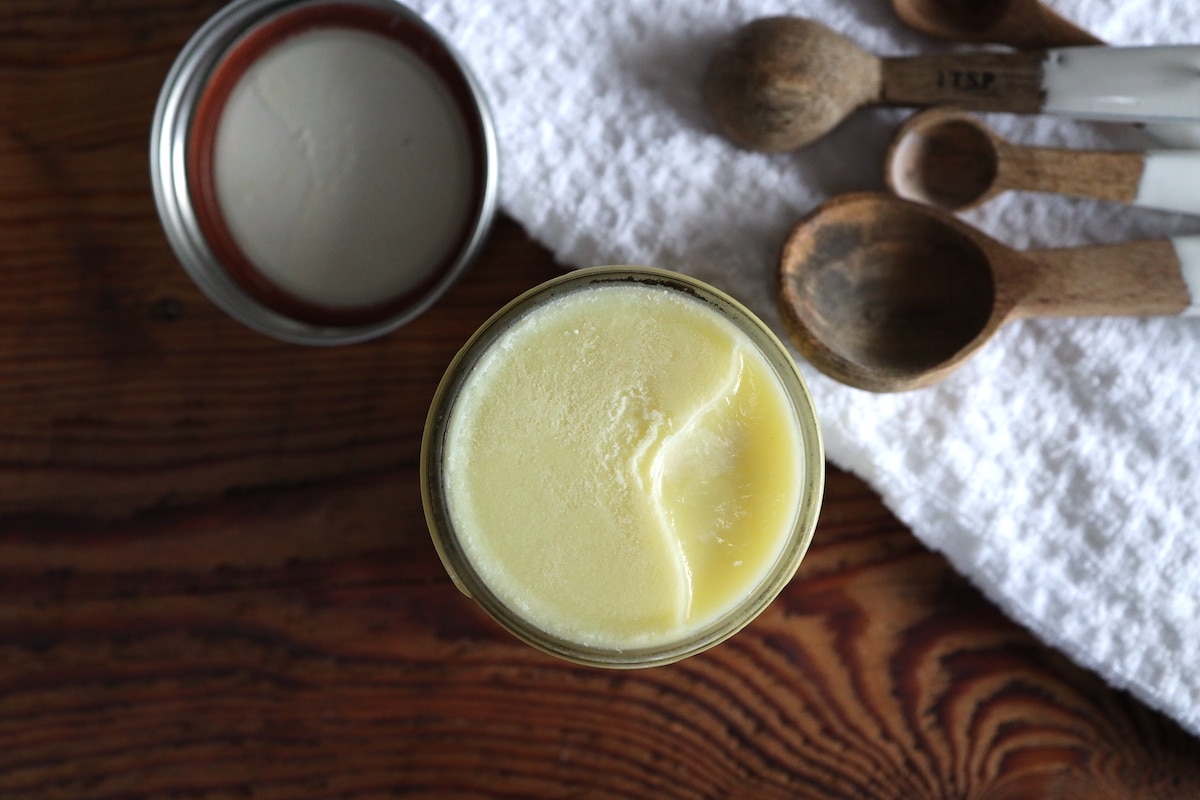
2. Whipped Tallow Balm
To make the whipped version, you do exactly the same thing as you would in the solid version. However, after your tallow and olive oil are mixed, instead of pouring them into a jar to store, let them solidify in a mixing bowl. Once they have solidified, mix with an immersion blender to create a texture akin to whipped cream. The downside to whipped tallow balm is that it doesn’t store as well. But it does create a more luxurious texture that is very easy to apply.
Can You Make Scented Tallow Balm?
Yes! If you prefer to add essential oils to your tallow balm, you can definitely do this. After you mix your melted tallow and olive oil together, add your essential oils. For adults, a 1% dilution is recommended and if applying on babies, a .25% dilution is safer.
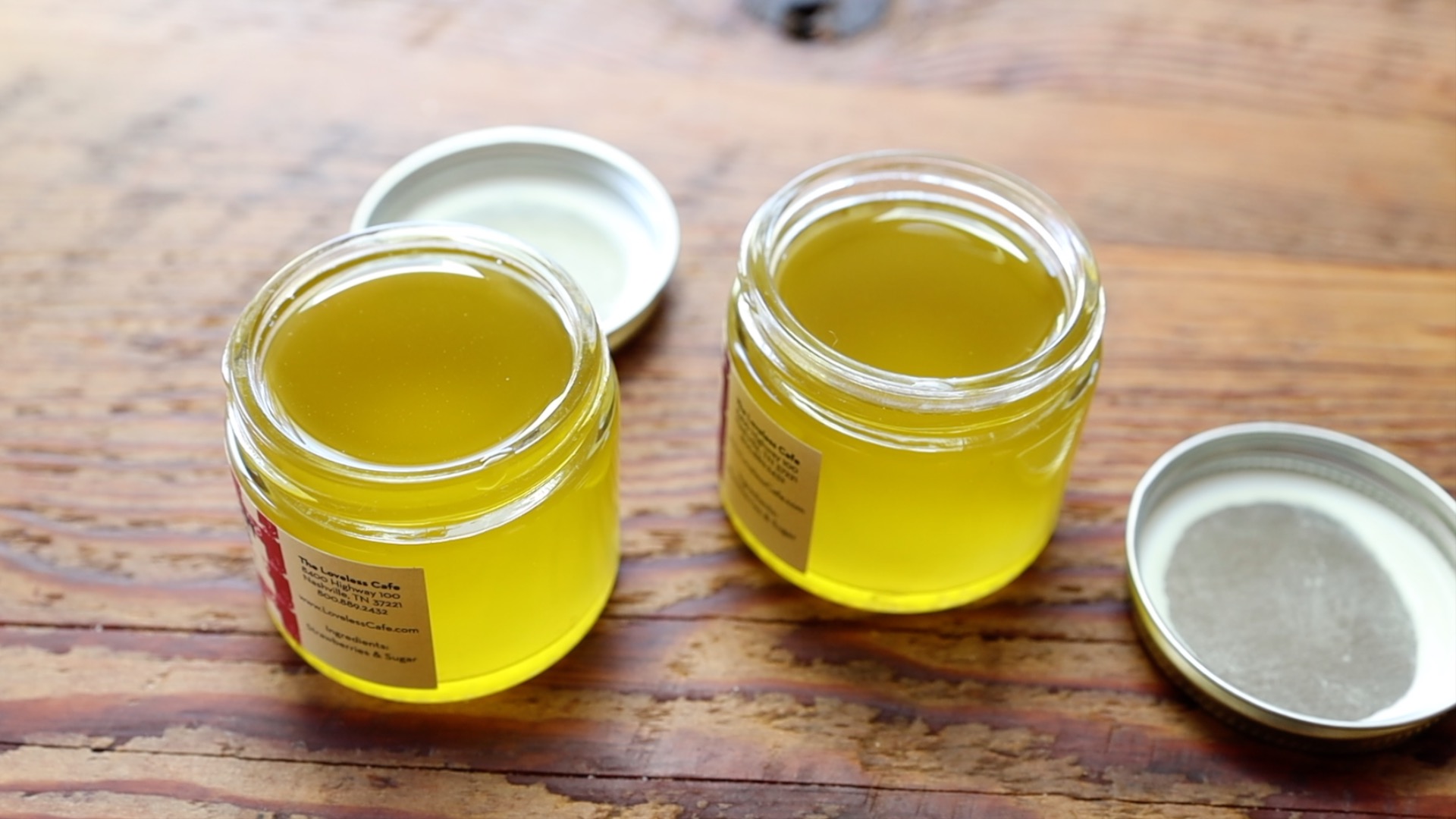
How do I Use Tallow Balm?
The beauty of tallow balm is that it is the perfect all-purpose moisturizer. It’s excellent for dry and cracked skin and can be applied to any part of the body including faces. Tallow balm is also my go-to lip balm as well as for babies and diaper rash.
Tallow Balm Recipe
Ingredients:
½ cup rendered tallow
2 tbsp olive oil
Directions:
1. Measure ½ cup of tallow and put in a heat safe jar or glass measuring cup.
2. Fill a small saucepan with water and, over low to medium heat, bring to heat with the container of tallow in the water.
Tip: To reduce the possibility of jars or measuring cups cracking while being heated, we like to lay a dish rag in the saucepan for the container holding your tallow in sit on top of.
3. Heat until the tallow is completely melted.

4. Remove from heat and stir in olive oil. Add essential oils if desired.
5. If making solid tallow balm, pour into a jar for storage. For whipped tallow balm, pour into a mixing bowl and let solidify. Once solid, mix with an immersion blender until a whipped cream consistency is achieved.
How to Store Tallow Balm?
Because tallow is a solid at room temperature, tallow balm will store in a small jar with a shelf life of several months in a dark place like a pantry or cupboard.

How to Source Tallow?
The first question we get when we start talking about making tallow-based skin care products is how do you find tallow or beef fat (suet)?
Our preference is always to work directly with a local farmer. Whether you are using the tallow in your cooking or skincare, quality makes a difference! Most of the toxins in an animal are stored in fat tissue so finding a clean, high-quality source of beef tallow is important!
Our preference is to use grass-fed tallow from cows on farms that follow regenerative practices. This helps to ensure that the tallow you are getting is not only going to be the best for you and your family but also best for the health of the animal and the planet.
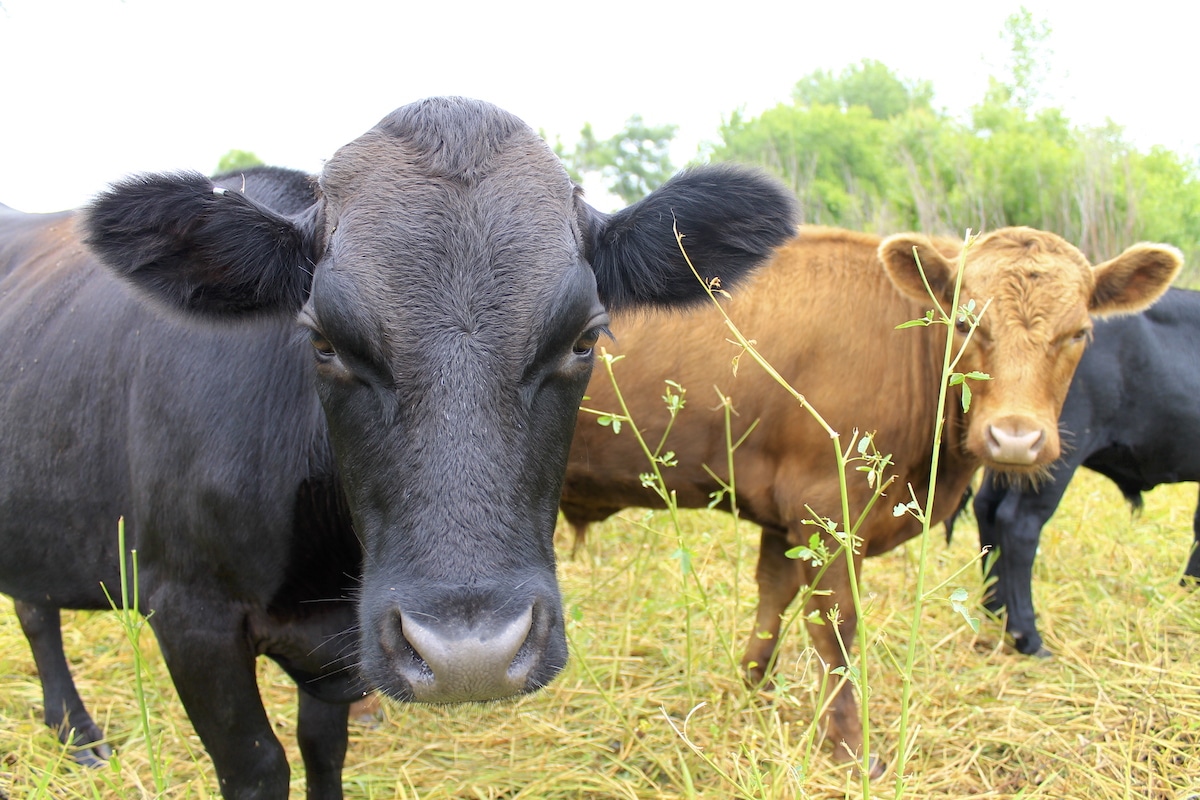
Thankfully, farms with regenerative practices are growing so hopefully you know of one in your local area. If not, websites like localharvest.org provide a directory of farmers to help you get connected with someone in your area.
If a local farm isn’t an option, you should also be able to find tallow at a local butcher. However, in our experience, it can be more difficult to find meat or fat from grass-fed animals from a butcher.
For more of our favorite tallow-based recipes, check out our:
Tallow Magnesium Lotion
Tallow Shampoo Bar
Wet Rendering Tallow
Tallow Deodorant
Tallow Sunscreen
Tallow Drawing Salve

Simple DIY Tallow Balm Recipe (2 Ingredients!)
It’s no secret that we are big fans of tallow around here. Whether using for cooking or skincare products, tallow is a staple for our family. After trying everything under the sun to help my skin, prone to dryness, tallow balm has been far and away my favorite.
Ingredients
- ½ cup rendered tallow
- 2 tbsp olive oil
Instructions
- Measure ½ cup of tallow and put in a heat safe jar or glass measuring cup.
- Fill a small saucepan with water and, over low to medium heat, bring to heat with the container of tallow in the water.
- Heat until the tallow is completely melted.
- Remove from heat and stir in olive oil. Add essential oils if desired.
- If making solid tallow balm, pour into a jar for storage. For whipped tallow balm, pour into a mixing bowl and let solidify. Once solid, mix with an immersion blender until a whipped cream consistency is achieved.
Pin it for later!
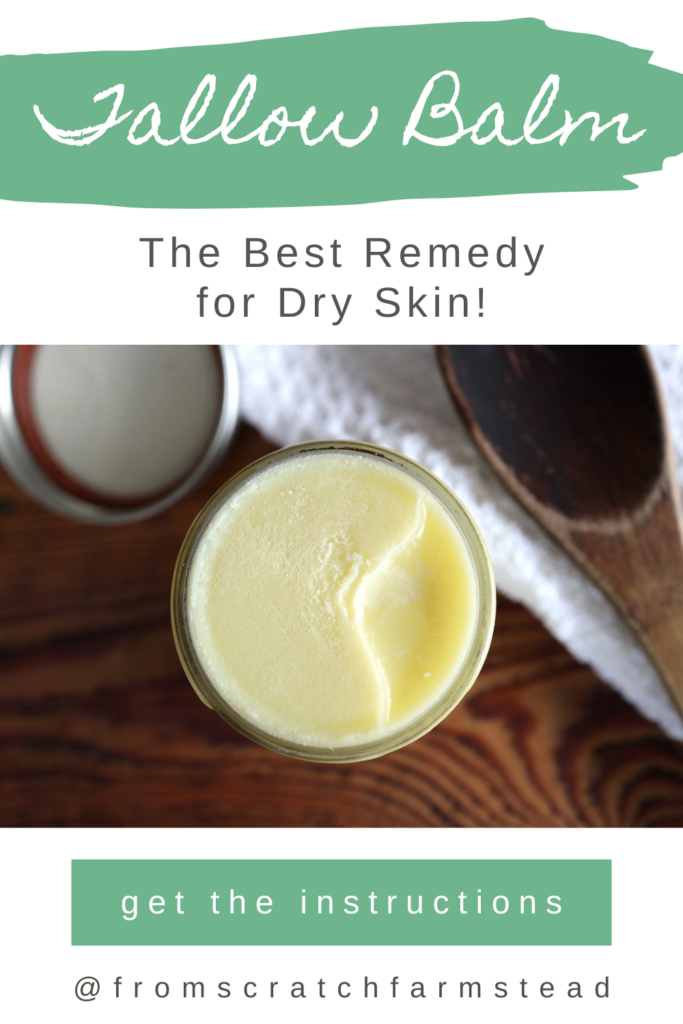




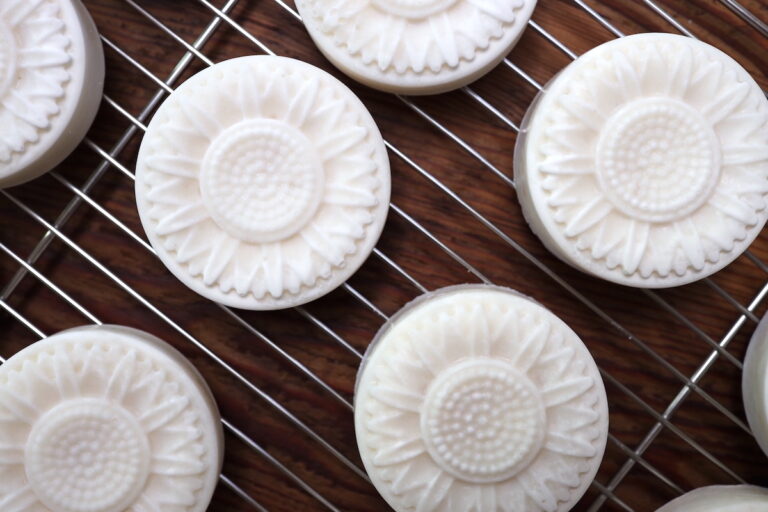
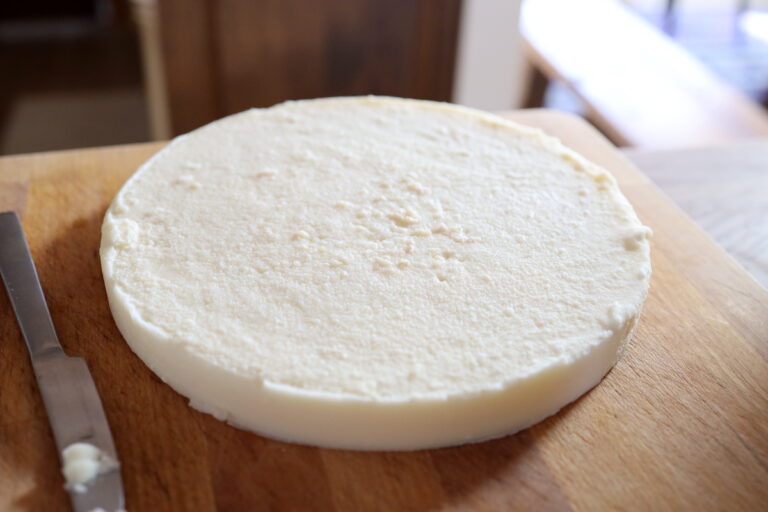
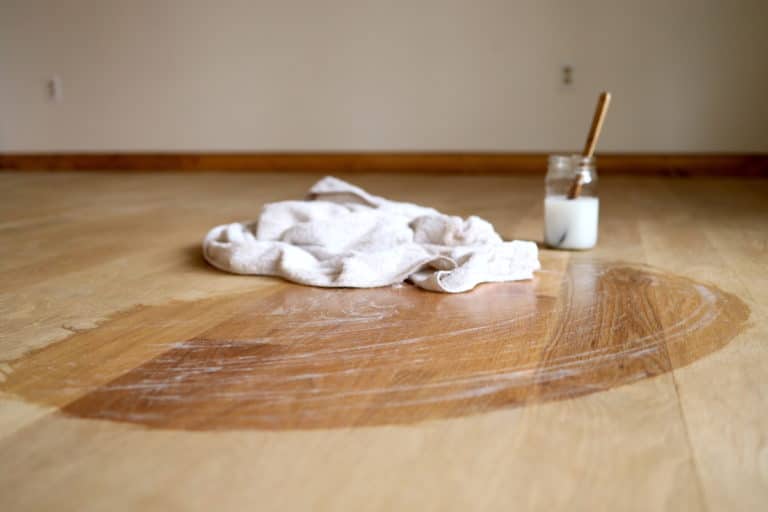
I’ve been pouring off and saving beggar from cooking ground beef. It’s so white and creamy! I was going to make soap, but I’ll give this a try. Thanks!
You’re welcome!!
Hi
I have some wagyu beef tallow from a company that said it is grass fed, but grain finished, it is pure white and creamy, is this ok to use for skin balm? Your honest answer of if you would feel right using it, is fine:)
Thanks,
Sheri
Hi Sheri! Yes, we would feel comfortable using it. Obviously grass fed/grass finished would be ideal, but we would personally be fine using it if that’s what we had. Thanks for stopping by!
For adding fragrance, how are you measuring the 1% of essential oils?
Hi! For 4 ounces of tallow balm, 1% would be just over one mL of essential oils or roughly 20 drops.
Hey! I’m just wondering if this can be stored on the counter or does it have to be refrigerated? And also, what’s the shelf life?
Thanks!
I keep it at room temperature and it stores very well for several months!
I love the tallow balm I made but I feel like it smells like meat on my skin. Does the smell dissipate? Will the essential oil actually help with this?
Did you use the wet method to render your tallow? I think it really helps to eliminate the beefy smell. But yes, I think essential oils can definitely help mask any odor.
Have you ever had any fungal infections as a result of using your tallow balm. I just read an article that people who DIY tallow balm are unaware of the hidden dangers of the microbes that can grow. Given, that was put out by a school that teaches how to make natural products, so I suspect it was a ploy to get people to sign up for their classes. Thoughts?
I’ve never heard of this! As tallow beauty products have gained popularity recently, I’ve see quite a bit of backlash against it for one thing or another. We’ve been using tallow balm for years and have never had any issues!
My tallow balm is a bit gritty once it’s whipped. Any idea why? I am using organic rendered beef tallow.
Have you only made it whipped? I’d be curious what the texture is like unwhipped? Wondering if it may just have to do with playing with length of time and speed it’s whipped? I don’t have personal experience with this but these are the things that come to mind!
Hi, I was wondering if the tallow is good to use as a baby’s bum cream?
Yes! We love to use it for this purpose!